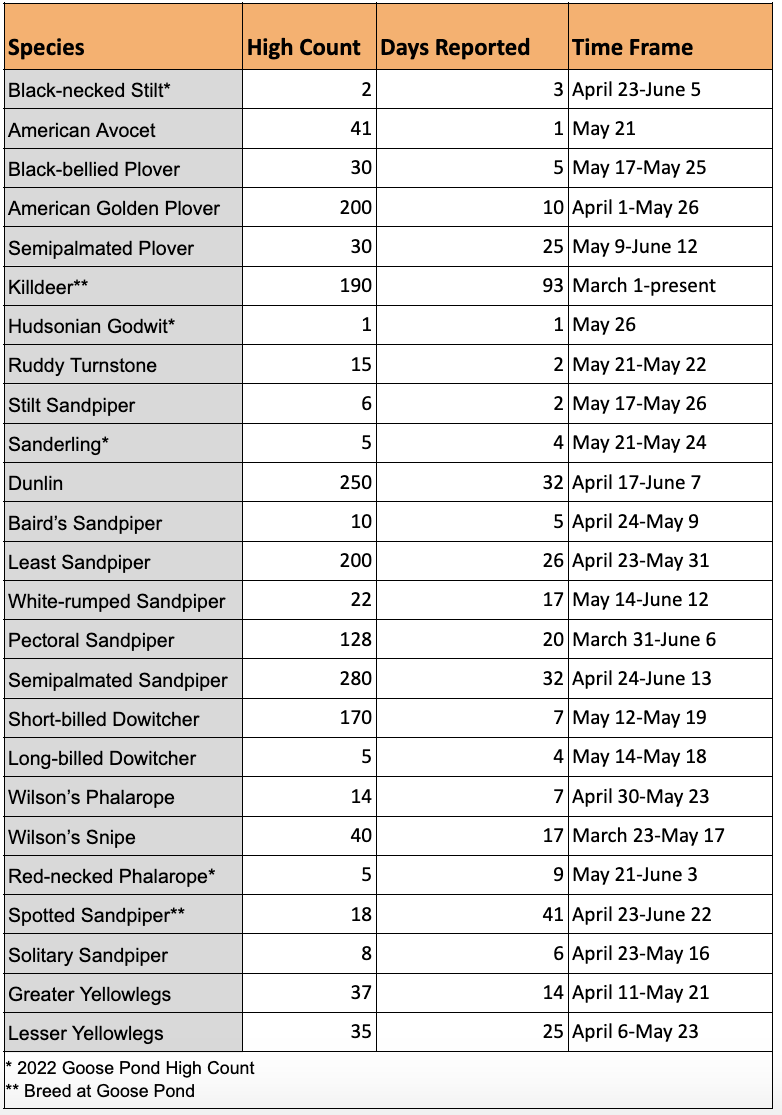Black-necked Stilt. eBird Photo by Bill Bunke.
As we say goodbye to spring and welcome the heat of summer, we must also bid farewell to the birds that keep even the most advanced birders turning the pages of their field guides: the shorebirds. From the difficult to discern ‘peeps’ to the unmistakable appearance of the Black-necked Stilt and American Avocet, shorebirds are a large reason spring birding is so exciting—though short-lived!
Most of the 25 shorebird species that visited Goose Pond this spring arrived in April and have not been reported since late May or early June. Although species that breed at Goose Pond such as Killdeers and Spotted Sandpipers were reported 93 and 41 times respectively, 20 species were reported less than 30 days total this spring (see chart below).
Why such a hurry? Despite shorebirds being a yearly highlight for Goose Pond Birders, Goose Pond is merely a small stop along a much larger journey from their wintering grounds in South America to their arctic breeding grounds. However, their fleeting nature can make spotting them that much more of a thrill! For example, I had heard that five Red-necked Phalaropes were seen on the West pond, so after work I rushed over to Prairie Lane and looked out my window at the place Mark suggested I may see them, and sure enough, there they were! I was lucky to have spotted them when I did because by the next day there was only one individual reported, and within the week, they were gone. To read more about this rare visitor, check out this past Feature!
Four Red-necked Phalaropes swimming on Goose Pond. eBird Photo by Darrell Schiffman
White-rumped Sandpipers and Dunlin foraging at Goose Pond. eBird Photo by Aaron Holschbach
Ruddy Turnstones foraging at Goose Pond. eBird Photo by JD Arnston
The chart below contains Goose Pond’s impressive list of shorebirds seen in Spring, 2022, as well as the Goose Pond high count, number of days reported, and the time frame in which they were sighted. Only 10 of Goose Pond’s 35 total shorebird species were not reported this spring including: Piping Plover, Upland Sandpiper, Whimbrel, Marbled Godwit, Red Knot, Ruff, Buff-breasted Sandpiper, Western Sandpiper American Woodcock, and Willet. This was an abnormally great year for shorebirds at Goose Pond due to the low water levels last fall that persisted into this spring. Read more about how shallow waters affect ‘shorebirding’ opportunities in a past post.
We would like to thank all of the dedicated Goose Pond Birders for providing such extensive data on shorebirds this spring, and all birds year-round. Without the submission of your eBird checklists, we would not have been able to compile the chart below, and would be missing valuable insight into the secret lives of the shorebirds. At the end of June early nesting shorebirds that nested in the arctic including yellowlegs are stopping to refuel at Goose Pond on their southerly migration.
Written by Emma Raasch, Goose Pond Sanctuary Staff
Cover photo: Group of Black-bellied Plovers at Goose Pond (eBird photo by Laura Wentz)










